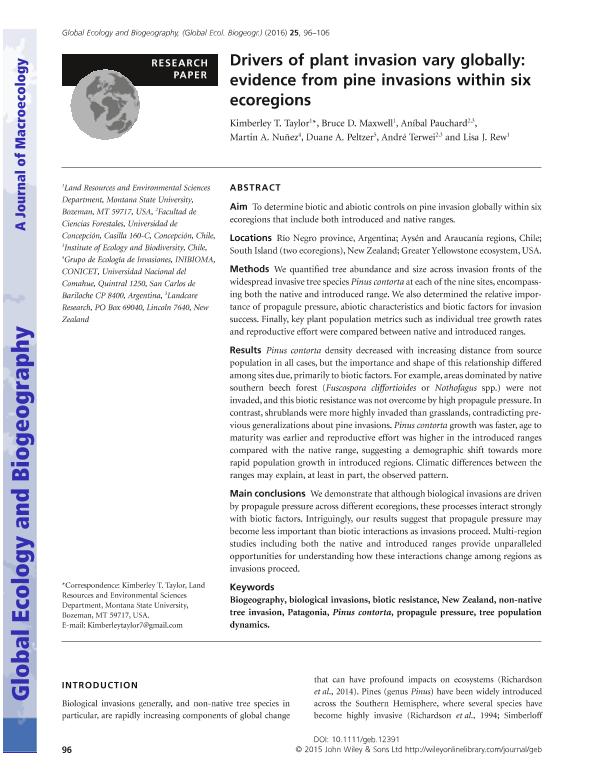Mostrar el registro sencillo del ítem
dc.contributor.author
Taylor, Kimberley T.
dc.contributor.author
Maxwell, Bruce D.
dc.contributor.author
Pauchard, Aníbal
dc.contributor.author
Nuñez, Martin Andres

dc.contributor.author
Peltzer, Duane A.
dc.contributor.author
Terwei, André
dc.contributor.author
Rew, Lisa J.
dc.date.available
2018-09-24T19:00:48Z
dc.date.issued
2016-01
dc.identifier.citation
Taylor, Kimberley T.; Maxwell, Bruce D.; Pauchard, Aníbal; Nuñez, Martin Andres; Peltzer, Duane A.; et al.; Drivers of plant invasion vary globally: Evidence from pine invasions within six ecoregions; Wiley Blackwell Publishing, Inc; Global Ecology and Biogeography; 25; 1; 1-2016; 96-106
dc.identifier.issn
1466-822X
dc.identifier.uri
http://hdl.handle.net/11336/60803
dc.description.abstract
Aim: To determine biotic and abiotic controls on pine invasion globally within six ecoregions that include both introduced and native ranges. Locations: Río Negro province, Argentina; Aysén and Araucanía regions, Chile; South Island (two ecoregions), New Zealand; Greater Yellowstone ecosystem, USA. Methods: We quantified tree abundance and size across invasion fronts of the widespread invasive tree species Pinus contorta at each of the nine sites, encompassing both the native and introduced range. We also determined the relative importance of propagule pressure, abiotic characteristics and biotic factors for invasion success. Finally, key plant population metrics such as individual tree growth rates and reproductive effort were compared between native and introduced ranges. Results: Pinus contorta density decreased with increasing distance from source population in all cases, but the importance and shape of this relationship differed among sites due, primarily to biotic factors. For example, areas dominated by native southern beech forest (Fuscospora cliffortioides or Nothofagus spp.) were not invaded, and this biotic resistance was not overcome by high propagule pressure. In contrast, shrublands were more highly invaded than grasslands, contradicting previous generalizations about pine invasions. Pinus contorta growth was faster, age to maturity was earlier and reproductive effort was higher in the introduced ranges compared with the native range, suggesting a demographic shift towards more rapid population growth in introduced regions. Climatic differences between the ranges may explain, at least in part, the observed pattern. Main conclusions: We demonstrate that although biological invasions are driven by propagule pressure across different ecoregions, these processes interact strongly with biotic factors. Intriguingly, our results suggest that propagule pressure may become less important than biotic interactions as invasions proceed. Multi-region studies including both the native and introduced ranges provide unparalleled opportunities for understanding how these interactions change among regions as invasions proceed.
dc.format
application/pdf
dc.language.iso
eng
dc.publisher
Wiley Blackwell Publishing, Inc

dc.rights
info:eu-repo/semantics/openAccess
dc.rights.uri
https://creativecommons.org/licenses/by-nc-sa/2.5/ar/
dc.subject
Biogeography
dc.subject
Biological Invasions
dc.subject
Biotic Resistance
dc.subject
New Zealand
dc.subject
Non-Native Tree Invasion
dc.subject
Patagonia
dc.subject
Pinus Contorta
dc.subject
Propagule Pressure
dc.subject
Tree Population Dynamics
dc.subject.classification
Otras Ciencias Biológicas

dc.subject.classification
Ciencias Biológicas

dc.subject.classification
CIENCIAS NATURALES Y EXACTAS

dc.title
Drivers of plant invasion vary globally: Evidence from pine invasions within six ecoregions
dc.type
info:eu-repo/semantics/article
dc.type
info:ar-repo/semantics/artículo
dc.type
info:eu-repo/semantics/publishedVersion
dc.date.updated
2018-09-24T13:52:57Z
dc.journal.volume
25
dc.journal.number
1
dc.journal.pagination
96-106
dc.journal.pais
Reino Unido

dc.journal.ciudad
Londres
dc.description.fil
Fil: Taylor, Kimberley T.. State University of Montana; Estados Unidos
dc.description.fil
Fil: Maxwell, Bruce D.. State University of Montana; Estados Unidos
dc.description.fil
Fil: Pauchard, Aníbal. Universidad de Concepción; Chile
dc.description.fil
Fil: Nuñez, Martin Andres. Consejo Nacional de Investigaciones Científicas y Técnicas. Centro Científico Tecnológico Conicet - Patagonia Norte. Instituto de Investigaciones en Biodiversidad y Medioambiente. Universidad Nacional del Comahue. Centro Regional Universidad Bariloche. Instituto de Investigaciones en Biodiversidad y Medioambiente; Argentina. Universidad Nacional del Comahue. Centro Regional Universitario Bariloche; Argentina
dc.description.fil
Fil: Peltzer, Duane A.. Crown Research Institutes. Landcare Research; Nueva Zelanda
dc.description.fil
Fil: Terwei, André. Universidad de Concepción; Chile. Institute of Ecology and Biodiversity; Chile
dc.description.fil
Fil: Rew, Lisa J.. State University of Montana; Estados Unidos
dc.journal.title
Global Ecology and Biogeography

dc.relation.alternativeid
info:eu-repo/semantics/altIdentifier/doi/https://dx.doi.org/10.1111/geb.12391
dc.relation.alternativeid
info:eu-repo/semantics/altIdentifier/url/https://onlinelibrary.wiley.com/doi/abs/10.1111/geb.12391
Archivos asociados
